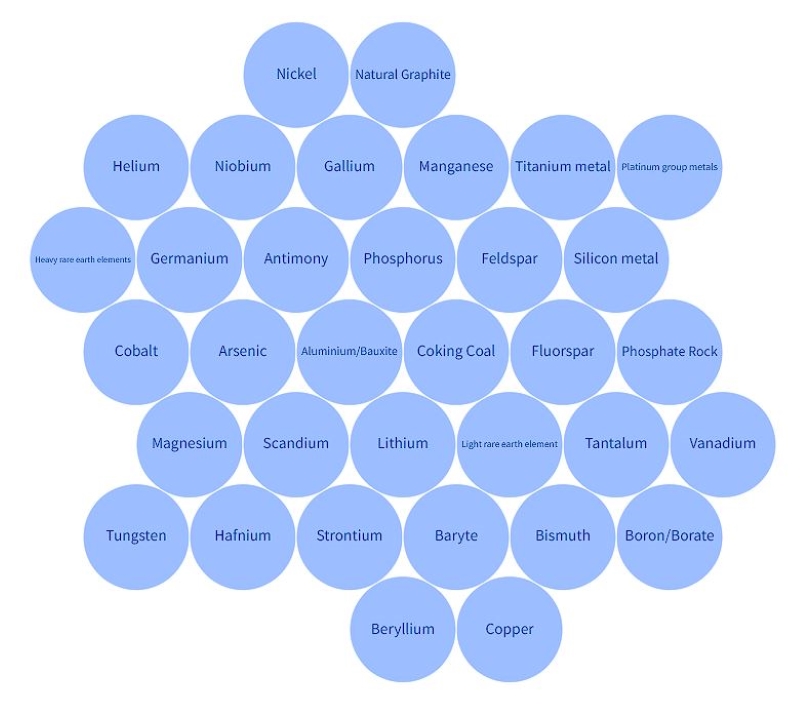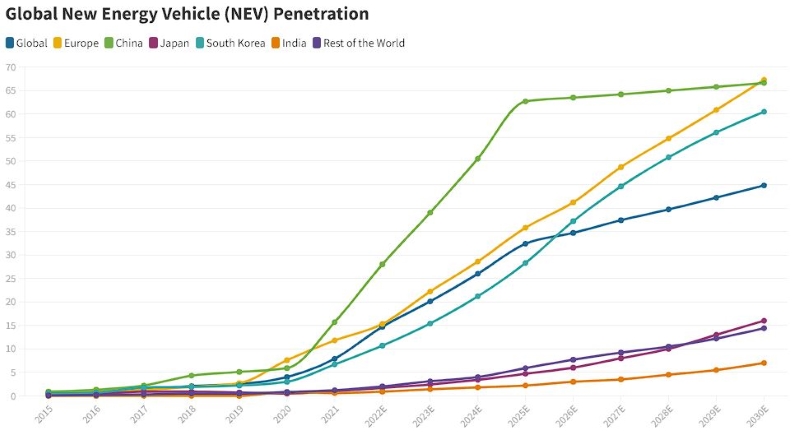The EU needs domestic critical minerals supply so the wheels don’t fall off
Mining
Mining
Truth. And so Europe was undoubtedly thrust into a state of shock recently after hearing that 74 yr-old cheese casaro Giacomo Chiapparini was crushed to death under the wheels of his own parmesan.
The cheese wheels – weighing in at 40kg each – fell in their thousands from the top of his warehouse after a shelf broke and it took firefighters 12 hours to retrieve Chiapparini’s body underneath his beloved Grana Padano.
But that’s not the only shock lately for Europe – it’s facing a domestic raw material production crisis for a range of critical minerals it requires for EVs, clean energy production and other technologies.
Moves such as China’s recent export restrictions of its monopoly on gallium and germanium – critical components in semiconductor chips – and high global demand have sparked the EU to hastily pass legislation to make its region more self-reliant in the mining, processing and recycling of such minerals.
34 of them in fact. The EU’s Critical Raw Materials Act was enacted earlier this year to secure future supply for downstream processing and manufacturing of critical metals and minerals as it largely imports most elements from third-party countries outside the EU. Let’s find out why:

European mining is old. Centuries-old. Yet nowadays, its homegrown mining is largely based on fossil fuel extraction and traditional mining of meagre amounts of gold and silver – importing most other minerals that are increasingly in demand as we pivot to net-zero emissions technologies.
Past colonialism by the majority of European powers – where they pillaged natural resources and brought them back home – has manifested into the necessary importation of a range of raw materials from places like China, Africa, Russia and more for far too long.
Thus creating a dependency on third-party nation-states outside of the EU for high-demand critical minerals.
It may sound cheesy to say this, but this lack of domestic critical mineral production could mean Europe gets economically crushed by its past successes.

Basically, if the EU doesn’t want the wheels to fall off its prestigious US$156bn (6.24% of total EU exports) car manufacturing sector and clean energy targets, it’s going to need to shore up stable supplies of these minerals in-house, otherwise OEMs are going to set up shop elsewhere.
The good news is, they’re actually doing something about it.
The Raw Materials Act sets these benchmarks along the strategic raw materials value chain and for the diversification of the EU supplies for:
Lofty goals, as currently, China supplies the EU with 80% of its REEs and imports high percentages of other strategic minerals used in battery manufacturing, such as lithium, nickel, copper and cobalt.
In March 2023, the European Union also proposed the Net Zero Industry Act, which aims to meet 40% of its needs for strategic net zero technologies using domestic manufacturing capacity by 2030.
These technologies explicitly include battery and storage, and for batteries, the aim is for nearly 90% of the European Union’s annual battery demand to be met by EU battery manufacturers, with a combined manufacturing capacity of at least 550GWh in 2030, in line with the objectives of the European Battery Alliance.
“The EU’s demand for base metals, battery materials, rare earths and more are set to increase exponentially as the EU divests from fossil fuels and turns to clean energy systems which necessitate more minerals,” the European Council says.
“The EU green transition will require the build-up of local production of batteries, solar panels, permanent magnets, and other clean tech. Abundant access to a range of raw materials will be needed to address the corresponding demand.”
Ergo, Europe is hungry to mine. And lucky for EU, there’s a bunch of ASX-listed explorers and mine developers looking to feed into its domestic supply chain.
In Austria, Battery Age Minerals (ASX:BM8) owns the Bleiberg project – once a major producer of zinc and lead; and at one point was among the largest primary germanium producers globally.
The explorer’s now added germanium to its “to-do” list at Bleiberg, where gallium mineralisation has also been found through historical workings at the project, recently announcing an expansion of its tenements.
“We are pleased to have secured additional ground adjacent to our existing Bleiberg Zinc-Lead-Germanium project,” BM8 MD Gerard O’Donovan said last month.
Also in Austria, Tony Sage-backed European Lithium (ASX:EUR) is concentrating on its Wolfsburg hard rock lithium project, recently selling its non-core Australian tenement around the Mt Anketell iron ore deposit in the Pilbara, keeping it laser-eyed on battery commodities for the European market.
Wolfsberg’s current MRE is 12.88Mt @ 1% Li2O and its DFS has highlighted the project’s economic viability – especially since it has an offtake agreement with BMW, a US$125m share subscription facility and an agreement with Saudi-backed Obeikan Investment Group.
EUR is about ~65% financed, and is looking at finalising a funding package for infrastructure, the construction start and resource extension drilling at the Zone 2 prospect which is currently not included in the MRE.
Exploring copper and gold at Sweden’s historic 1,000yr old Falun mine is Alicanto Minerals (ASX:AQI), which has recently received commitments to raise $3m to kickstart drilling at the project.
Multiple high-priority targets have been identified, comprised of both copper-gold and zinc-copper-lead, especially along 3.5km of mineralisation where limited drilling was conducted last year.
Alicanto has also been conducting step-out drilling at its Sala silver-zinc project, also in Sweden, which has a current resource of 9.7Mt, with recent re-assaying of historic cores showing 1.1m @ 1,326g/t silver, 0.8% zinc and 6.6% lead; as well as 3.9m at 737g/t silver, 1.2% zinc and 11.8% lead near the historic Bronäs mine.
It seems like Sweden’s becoming a bit of a hotspot for mining again for ASX juniors looking to boost Europe’s green tech push.
Zinc of Ireland (ASX:ZMI) has its eyes on zinc mineralisation at its Rathdowney project where it controls 75 prospecting licences across 2,500km2 with a trend that goes for a whopping 130km.
Previously mined for zinc and lead, ZMI is looking to further exploration on the back of a 2020 MRE of 11.3Mt @ 9% Zn+Pb (7.8% Zn and 1.2% Pb) @ a 5% Zn equivalent cut-off.
ZMI reckons it controls “arguably one of the most prospective land packages for high grade, large tonnage, Zn/Pb deposits in the world”.
Samples are actively being taken at the Rathdowney trend and the explorer is assessing geochemical assays.
Off to the Balkans now and precious metals explorer Adriatic Metals (ASX:ADT) is on a tear after releasing a 93% increase of the indicated and inferred MRE of its Rupice deposit – part of its Vares silver project in Bosnia and Herzegovina last month.
It now stands at an impressive 21.1Mt @ 156g/t Ag, 1.2g/t Au, 4.3% Zn, 2.8% Pb, 0.4% Cu, 27% BaSO4 (reported above a cut-off grade of 50 g/t AgEq) for a contained 105Moz Ag, 789koz Au, 913kt Zn, 581kt Pb, 88kt Cu and 39kt Sb.
The near-term producer says construction is 84% complete (as of June 30 this year) and first concentrate is expected in November.
Based off the results, Adriatic is now raising US$30m to complete construction and prove up more resources.
“Following a very successful exploration campaign and the recently announced MRE at Rupice and Rupice Northwest, we are pleased to announce an equity placing of US$30 million to fund an expanded and accelerated exploration programme in 2023 and 2024,” ADT MD Paul Cronin says.
“Rupice and Rupice Northwest remain open and there are numerous regional targets such as Droskovac, SP1 and SP2 that have exciting prospects.
“We believe this exploration programme will deliver impactful results by more aggressively testing priority targets across our emerging high-grade polymetallic district.”
Finally – and staying in Bosnia and Herzegovina – Lykos Metals -LYK (ASX:) is making strides towards exploration approvals for its highly-prospective copper-gold tenements at the Sinjakovo project after being hamstrung by red tape.
“After nearly two years of intensive negotiations, the Government of the Republic of Srpska has taken a decisive stance to protect foreign investments in geological exploration,” LYK CEO Milos Bosnjakovic says.
“This represents a momentous step forward not only for our company but also for the economy of the Republic of Srpska, and the local municipalities where we have been actively engaged since listing and intend to conduct future exploration activities.”
While Alicanto, European Lithium, Battery Age Metals and Zinc of Ireland are Stockhead advertisers, they did not sponsor this article.